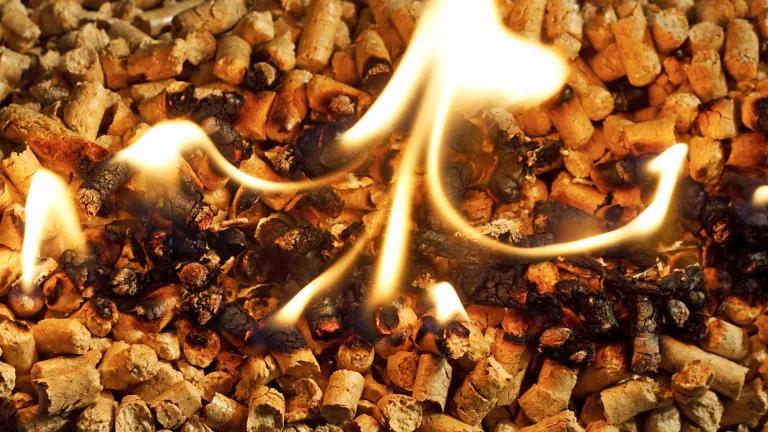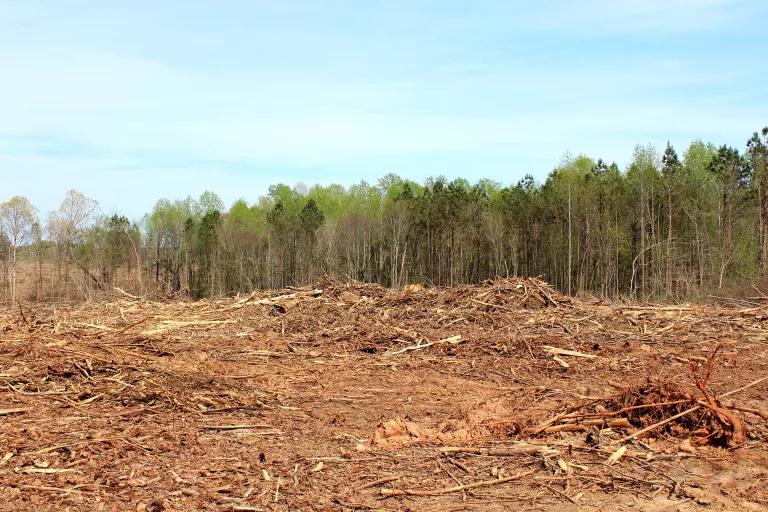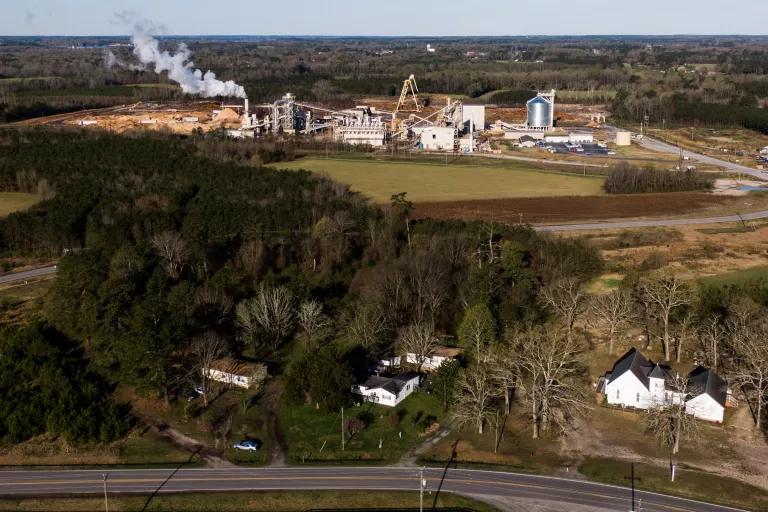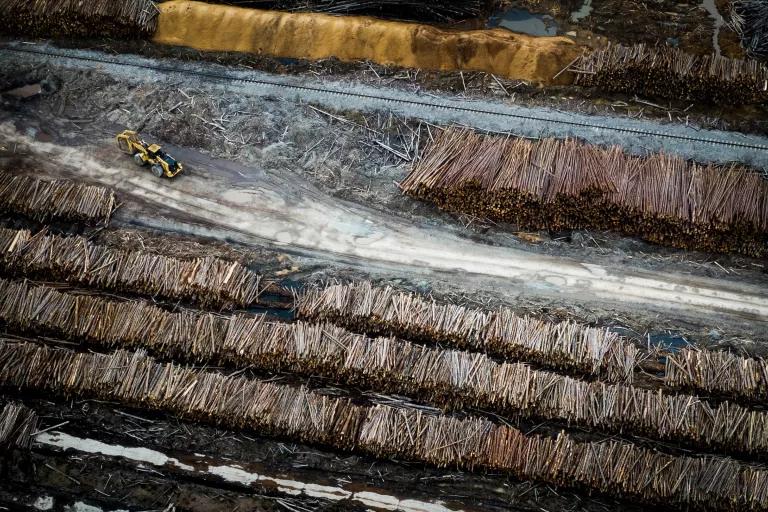No, Burning Wood Fuels Is Not Climate-Friendly
As Europe and the United States look to cut their carbon emissions, the biomass industry wants us to pretend that logging forests in the American South could help.

Burning wood chip pellets
Dreamstime
When the European Union (E.U.) created a Renewable Energy Directive in 2009 to encourage its member countries to transition away from fossil fuels, it made the mistake of defining wood biomass as a renewable energy source. In the years since, subsidies under the directive have caused the wood biomass industry to take off, with huge consequences for the climate, forests, and local communities.
“When these E.U. policies were first coming up, there appeared to be a genuine misunderstanding about the carbon impacts from biomass,” says Heather Hillaker, a staff attorney with the environmental nonprofit Southern Environmental Law Center (SELC). “This is not the magical solution we've been looking for to fight climate change.”
Ground zero for wood biomass production, in which wood is compressed into pellets to be burned for fuel, are the pine and hardwood forests of the southern United States. There are a whopping 23 mills in the region, with a potential output of more than 10 million tons of wood biomass annually. In North Carolina alone, Enviva, the world’s largest wood pellet producer, operates four facilities and may be planning to open a fifth in the region in 2024.
Most of the biomass produced in the South heads overseas, and British company Drax is one of Enviva’s biggest customers. At its power station in northern England, Drax converted four generating units from coal to biomass, and in 2018, generated 7.4 percent of the United Kingdom’s “renewable” power. In 2020, Drax reportedly earned £832 million (more than $1 billion) in government subsidies, plus an estimated £258 million ($340 million) in tax incentives for biomass production.
The E.U.’s Renewable Energy Directive “opened up the floodgate for the biomass industry to establish itself in the Southeast and to become the new threat to Southern communities and forests,” says Rita Frost, campaigns director at Dogwood Alliance, a North Carolina–based nonprofit focused on the protection of Southern forests.

A clearcut section of a mature hardwood forest in the Tar-Pamlico River Basin in North Carolina
Dogwood Alliance
A double whammy for climate and forests
In a report published in October by the London-based global policy institute Chatham House, scientists estimate that wood pellets sourced in the United States and burned for energy in the United Kingdom emitted up to 17.6 million tons of carbon dioxide in 2019, yet most of this carbon accounting wasn’t included in the U.K. national greenhouse gas inventory. If it had been, it would have raised the emissions of the electricity generation sector between 22 and 27 percent. Further, the industry’s claim that switching from burning coal to wood biomass reduces greenhouse gas emissions up to 85 percent is scientifically indefensible.
“At the smokestack,” says Sami Yassa, a senior scientist with NRDC’s Climate & Clean Energy Program, “wood emits more carbon dioxide than coal for every unit of electricity produced.” In fact, the Partnership for Policy Integrity, a U.S.-based group that advocates for data-driven environmental policies, finds that power plants that burn biomass emit 150 percent more carbon dioxide than those burning coal. And of course, through logging forests to produce the pellets, the wood biomass industry is harming the climate every step of the way.
A 2018 study published in Environmental Research Letters used data from forests in the eastern United States to develop a bioenergy life cycle model that examined the impact of substituting wood biomass for coal in energy production. The researchers found that after a clearcutting, it would take between 44 and 104 years to repay the carbon debt, even if trees were replanted. The very act of clearcutting releases vast amounts of the carbon that is stored in a forest’s trees and soils. And fast-growing pine plantations are poor replacements for established hardwood forests, since they are not only less biodiverse but also worse at sequestering carbon.
Allowing the forests to regenerate naturally is also still a loss for the climate. Wetlands and other waterlogged forests, Frost says, simply do not bounce back quickly enough, leaving wildlife without habitat and North Carolina’s hurricane-prone communities without adequate protection from storm surges, since coastal forests and wetlands can buffer a storm’s impact.

The Enviva wood pellet factory in Garysburg, North Carolina
Erin Schaff/The New York Times via Redux
The pellet industry’s neighbors
Without the European subsidies, the wood pellet boom in the Southeast wouldn’t exist—and neither would the air pollution it generates. In communities near biomass production sites, reports of thick smoke and smoldering wood piles abound. Between 2014 and 2018, local residents reported fires and explosions at eight of the country’s 15 largest wood pellet manufacturing facilities.
According to Dogwood Alliance, people of color make up about 65 percent of the populations around these sites in North Carolina, and the incomes of about a quarter of those residents are under the poverty level.
“There's a reason why the wood pellet biomass industry continues to set up shop in those communities,” Frost says. “They're systematically targeted. People are worn down. They’ve already been dumped on by a lot of different polluting industries.”
A 2018 report by the Environmental Integrity Project (EIP) found that at least a third of the wood pellet plants in the United States emitted illegal amounts of pollution, such as volatile organic compounds, particulate matter, soot, and nitrogen oxide—chemicals that make the air smoggy and contribute to lung diseases. And more than half either hadn’t installed the required pollution controls or had failed to keep emissions below legal limits. For instance, between 2016 and 2021, the Enviva manufacturing plant in Sampson County received five air quality violations from the North Carolina Department of Environmental Quality (DEQ).
Then in Richmond County in 2019, SELC and EIP challenged the DEQ over the air quality permits it issued to the Enviva plant there. The lawsuit argued that the agency underestimated the amount of pollution released from the plant, allowing Enviva to bypass stringent air pollution controls and violate the Clean Air Act.
Enviva settled the case and agreed to install additional technologies to reduce its volatile organic compound emissions. But Frost says that’s a small consolation to the communities living near the plants and it does little to offset the overall environmental impacts of wood pellet production. She adds that many local residents are forced to wear masks, suffer with respiratory illnesses, leave their windows closed to keep dust out, and struggle to sleep at night due to the noise coming from the plant and its many trucks.
“We need to expose biomass for what it is,” Frost says. “It’s a harm to the climate, a harm to the forests, and a harm to the communities where it operates.”

Logs at an Enviva wood pellet factory in Garysburg, North Carolina
Erin Schaff/The New York Times via Redux
A dangerous push for more biomass at home
In addition to its demand from abroad, wood biomass also threatens to become a more popular energy source stateside. Enviva recently acquired its first U.S. customer, a biofuel refinery in the Southeast, and the company plans to double its capacity at its Southeast plants over the next five years.
“Right now, biomass combustion is not a big thing in North Carolina,” says Hillaker, “but the concern is, of course, Enviva would love a market closer to home; to not have to expend the resources to ship its pellets all over the world.”
And recent federal legislation is making some of the same mistakes as the European Union did back in 2009. The U.S. biomass industry wants subsidies and exemptions from regulations, and is attempting to achieve them by falsely claiming that forest biomass is carbon neutral, says Yassa. “Once policies are in place,” he says, “ it’s going to take a major effort to reverse them.”
The 2022 infrastructure bill, for instance, refers to biomass as a renewable energy resource, approves subsidies for logging on federal public lands, and offers subsidies for wood pellet facilities. In an open letter written in November, more than 100 scientists urged President Biden to remove provisions that promote forest biomass from the bill, warning that “such measures will only make worse the global climate and biodiversity crises.”
Wherever the demand for wood pellets comes from, North Carolina forests will bear the brunt of it due to the state’s thriving logging industry and limited forestry regulations. North Carolina is home to 19 million acres of forest that store nearly 1.3 trillion tons of carbon, but Dogwood Alliance estimates that 164 acres of forest are lost each day to supply the wood pellet industry.
Although Enviva writes on its website that it uses only “waste” wood from sawmills and wood manufacturers to make its pellets, Yassa says, “Those claims are patently false.” He points to a 2013 investigative feature in the Wall Street Journal that found that Enviva was sourcing wood from 100-year-old clearcuts in wetland hardwood forests to supply its mills.
Enviva also touts its work with landowners to replant forests but as Frost notes, most landowners replant monocultures of pines. The result? The transition of southern forests from thriving ecosystems into industrial landscapes.
“Pine plantations can't hold up a mirror to natural forest when it comes to carbon sequestration,” Frost says. “We're taking away a really good carbon store, and that’s a problem when the product is supposed to be a climate solution.”
This NRDC.org story is available for online republication by news media outlets or nonprofits under these conditions: The writer(s) must be credited with a byline; you must note prominently that the story was originally published by NRDC.org and link to the original; the story cannot be edited (beyond simple things such as grammar); you can’t resell the story in any form or grant republishing rights to other outlets; you can’t republish our material wholesale or automatically—you need to select stories individually; you can’t republish the photos or graphics on our site without specific permission; you should drop us a note to let us know when you’ve used one of our stories.
What Are the Causes of Climate Change?
When Customers and Investors Demand Corporate Sustainability
The Uinta Basin Railway Would Be a Bigger Carbon Bomb Than Willow
What Are the Causes of Climate Change?
When Customers and Investors Demand Corporate Sustainability
The Uinta Basin Railway Would Be a Bigger Carbon Bomb Than Willow
What Are the Causes of Climate Change?
When Customers and Investors Demand Corporate Sustainability
The Uinta Basin Railway Would Be a Bigger Carbon Bomb Than Willow
What Are the Causes of Climate Change?
When Customers and Investors Demand Corporate Sustainability